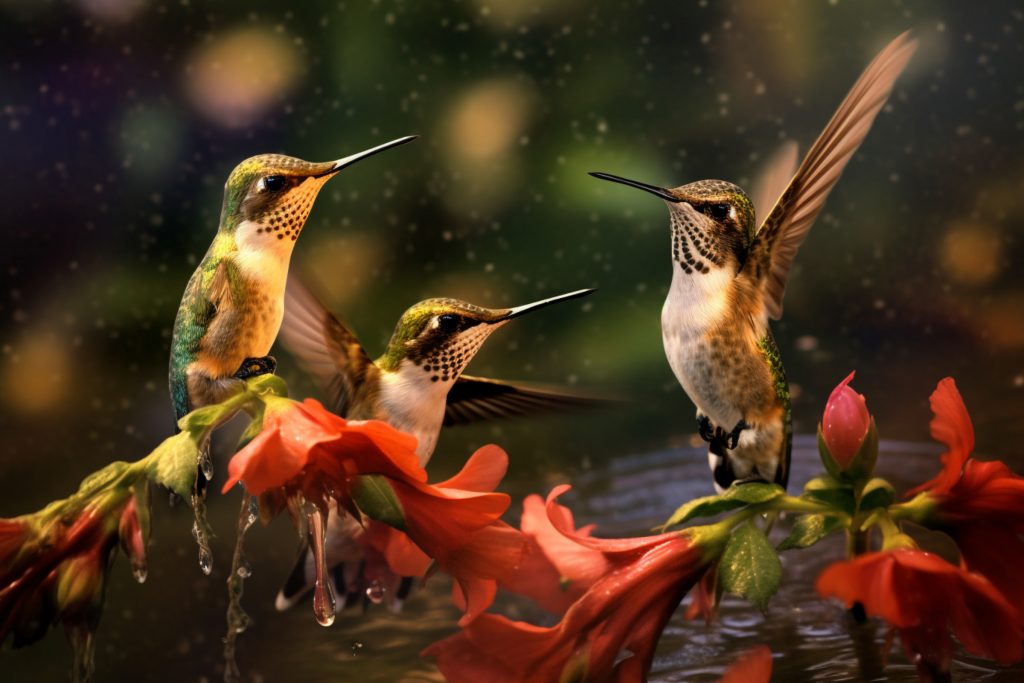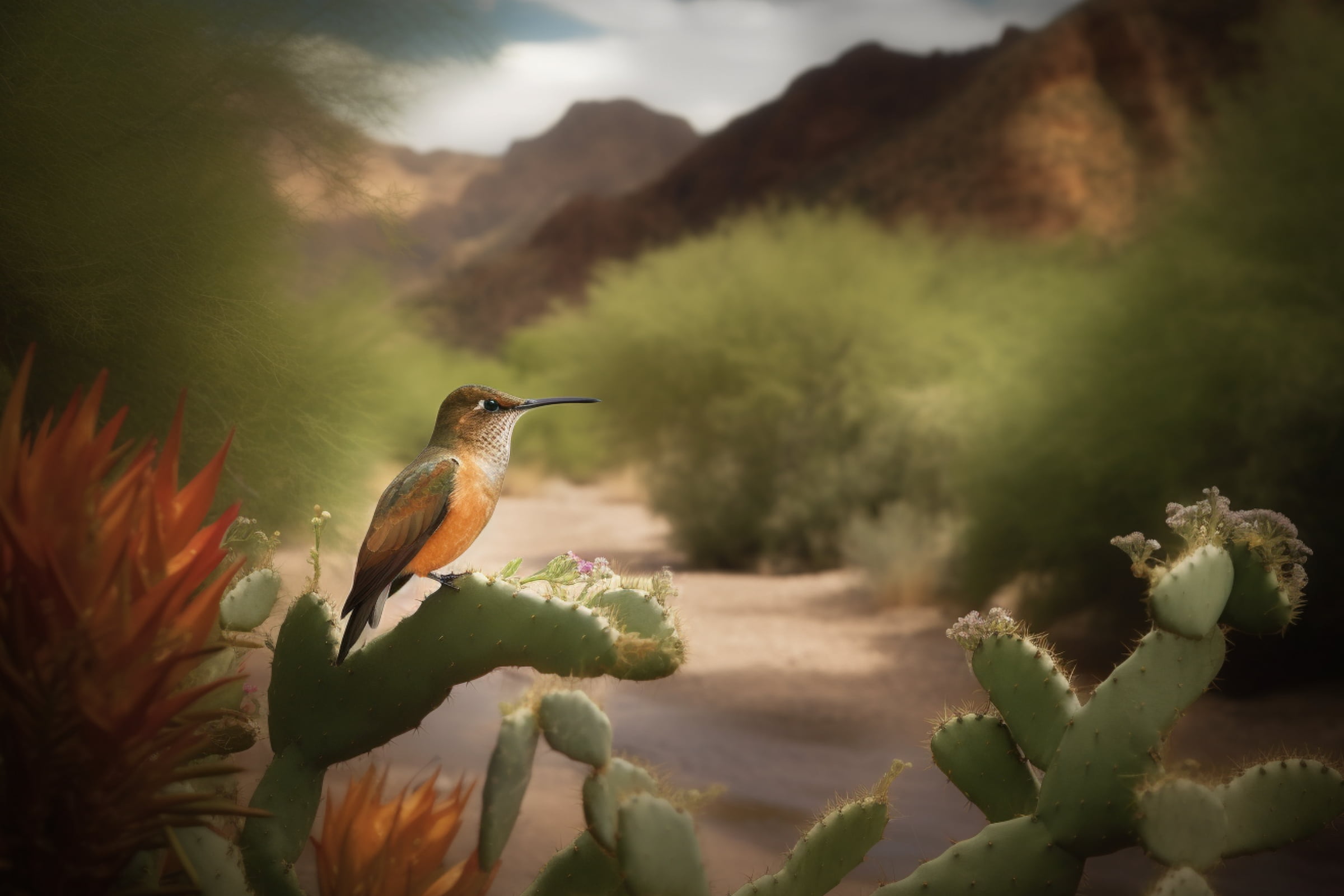Yes, there are indeed hummingbirds in Arizona! This state hosts an impressive range of hummingbird species, from the vibrant Rufous Hummingbird to the sleek Black-Chinned Hummingbird and the intriguing Broad-Tailed Hummingbird. With their bright, jewel-like colours and ceaseless energy, these birds are a sight to behold for any bird lover or casual observer.
In this blog post, we will explore the world of these fascinating creatures. We’ll delve into their preferred habitats in Arizona, the special characteristics of different species, their migration patterns, and how you can invite them into your garden with hummingbird feeders and native flowers.
- Hummingbird Species in Arizona
- Preferred Habitats and Food Sources
- Migration Patterns
- Attracting Hummingbirds to Your Garden
- The Plight of the Hummingbird
- Conclusion
- FAQs – Are There Hummingbirds in Arizona?
- Q: What species of hummingbirds can you find in Arizona?
- Q: How can you identify a Rufous Hummingbird?
- Q: What characteristics define a Black-Chinned Hummingbird?
- Q: What's unique about the Broad-Tailed Hummingbird?
- Q: How can I attract hummingbirds to my garden?
- Q: When do hummingbirds migrate to and from Arizona?
- Q: What is the preferred habitat of hummingbirds in Arizona?
- Q: Are hummingbirds solitary or social birds?
- Q: What threats are currently facing hummingbirds in Arizona?
- Q: What's being done to conserve hummingbirds in Arizona?
- Q: What is the general body size of hummingbirds?
- Q: What's the hummingbird with a violet crown called?
- Q: Are there albino hummingbirds?
- Q: Which hummingbird species can be found in the desert scrubs of Arizona?
- Q: What's the characteristic feature of a Blue-Throated Hummingbird?
- Q: Can you find Anna's Hummingbird in Arizona?
- Q: What does the Female Violet-crowned hummingbird look like?
- Q: Which hummingbird species is known for its blue throat?
- Q: What is the main diet of hummingbirds?
- Q: What do hummingbird feeders mimic?
Hummingbird Species in Arizona
Rufous Hummingbird
This aggressive hummingbird is known for its stunning copper-red or rufous plumage and forked tail. Interestingly, female hummingbirds of this species are green with some rufous or orange spots. They are a common species and migrate annually between North America, where their breeding grounds are located, and wintering grounds in Mexico.

Black-Chinned Hummingbird
A medium-sized hummingbird, the Black-Chinned Hummingbird, features a black throat with a characteristic purple band at the bottom and a white breast. They’re found in the United States from the western Texas area to British Columbia during the summer months and migrate to Mexico and Central America in late summer.
Broad-Tailed Hummingbird
Another common resident, the Broad-Tailed Hummingbird, is renowned for its metallic green body and rounded tail. Male birds have brilliant magenta throat feathers, while females exhibit a more modest white throat with speckled green feathers. These birds thrive in pine-oak forests and deciduous forests.
Other Notable Birds
Arizona also plays host to several other types of hummingbirds, like the Blue-Throated Hummingbird, the Lucifer Hummingbird, and the Violet-Crowned Hummingbird. The state’s unique habitat range allows these bird species to thrive, despite global habitat loss.
Preferred Habitats and Food Sources
Hummingbirds in Arizona generally prefer habitats that offer a variety of native plants, such as tubular flowers that provide nectar, a natural food source. They are also fond of places like the Cave Creek Canyon and the Oak Creek Canyon, both hot spots for these birds due to the abundant native flowers and food sources.
Hummingbirds are also drawn to hummingbird feeders, artificial nectar sources that you can hang in your garden. These can be filled with a simple sugar-water solution that mimics the nectar from flowers they naturally feed on.

Migration Patterns
Many hummingbird species migrate from Central and South America to the United States in late spring for the breeding season before returning to their wintering grounds in the south during the late summer and early autumn. This annual migration means that during certain periods, the hummingbird population in Arizona can increase significantly.
Attracting Hummingbirds to Your Garden
Hummingbird feeders can make your garden an inviting place for these beautiful birds. Additionally, planting native flowers that provide a natural nectar source will also attract these birds. Just remember, hummingbirds are solitary birds, and while they might tolerate other hummingbirds around a plentiful food source, they can be quite territorial.
The Plight of the Hummingbird
Despite the vibrancy and resilience of these birds, habitat loss and changes in their migration patterns due to climate change pose serious threats to their survival. The Paton Center for Hummingbirds in Arizona is one of the bird sanctuaries actively working on the conservation of these birds and their habitats.
Conclusion
In conclusion, Arizona is indeed home to a myriad of hummingbird species, each one unique and mesmerising. Witnessing these fast-flitting, jewel-like birds in their natural habitat, whether in a national forest or your backyard, is indeed a sight to behold. But remember, it’s our collective responsibility to ensure that future generations can also marvel at these birds. So, let’s strive to preserve their habitats and ensure their survival for many years to come.
Perhaps, the next time you spot a hummingbird in Arizona, you’ll see more than just a beautiful bird – but a creature representing the delicate balance of nature.
FAQs – Are There Hummingbirds in Arizona?
Q: What species of hummingbirds can you find in Arizona?
A: Arizona hosts several species of hummingbirds, such as the Rufous Hummingbird, Black-Chinned Hummingbird, Broad-Tailed Hummingbird, Blue-Throated Hummingbird, Lucifer Hummingbird, Violet-Crowned Hummingbird, and occasionally, the Ruby-throated Hummingbird.
Q: How can you identify a Rufous Hummingbird?
A: Rufous Hummingbirds are known for their vibrant copper-red or rufous plumage and forked tail. They are considered an aggressive hummingbird species.
Q: What characteristics define a Black-Chinned Hummingbird?
A: Black-Chinned Hummingbirds are medium-sized hummingbirds with a black throat and a purple band at the bottom. They also feature a white breast.
Q: What’s unique about the Broad-Tailed Hummingbird?
A: Broad-Tailed Hummingbirds are known for their metallic green bodies and rounded tails. Males have brilliant magenta throat feathers, while females display a more modest speckled green and white throat.
Q: How can I attract hummingbirds to my garden?
A: You can attract hummingbirds to your garden by hanging hummingbird feeders and planting native flowers that offer natural nectar sources. These birds are particularly drawn to tubular flowers.
Q: When do hummingbirds migrate to and from Arizona?
A: Many hummingbird species migrate to Arizona from Central and South America in late spring for the breeding season. They return to their wintering grounds in the south during late summer and early autumn.
Q: What is the preferred habitat of hummingbirds in Arizona?
A: Hummingbirds in Arizona typically prefer habitats with a variety of native plants, including tubular flowers, and regions rich in food sources like the Cave Creek Canyon and Oak Creek Canyon.
A: Hummingbirds are generally solitary birds. While they might tolerate other hummingbirds around a plentiful food source, they can be quite territorial.
Q: What threats are currently facing hummingbirds in Arizona?
A: Habitat loss and changes in migration patterns due to climate change pose serious threats to hummingbirds in Arizona.
Q: What’s being done to conserve hummingbirds in Arizona?
A: Bird sanctuaries such as the Paton Center for Hummingbirds are actively working on the conservation of these birds and their habitats.
Q: What is the general body size of hummingbirds?
A: Most hummingbirds are small, often measuring around 8-9 cm in length.
Q: What’s the hummingbird with a violet crown called?
A: The hummingbird with a violet crown is aptly named the Violet-Crowned Hummingbird.
Q: Are there albino hummingbirds?
A: Albino hummingbirds are incredibly rare, but they do exist. They are usually identified by their white feathers and pink eyes.
Q: Which hummingbird species can be found in the desert scrubs of Arizona?
A: The Lucifer Hummingbird is one species that thrives in the desert scrubs of Arizona.
Q: What’s the characteristic feature of a Blue-Throated Hummingbird?
A: As their name suggests, Blue-throated Hummingbirds have a notable bright blue-green gorget or throat patch.
Q: Can you find Anna’s Hummingbird in Arizona?
A: Yes, Anna’s Hummingbird is a common resident in the southwestern United States, including Arizona.
Q: What does the Female Violet-crowned hummingbird look like?
A: Female Violet-crowned hummingbirds are olive green with a white underpart and a faintly violet crown.
Q: Which hummingbird species is known for its blue throat?
A: The Blue-throated Hummingbird, also known as Blue-throated mountain gems, is known for its distinctive blue throat.
Q: What is the main diet of hummingbirds?
A: Hummingbirds mainly feed on the nectar from flowers, which provides them with the high energy they require. They also feed on insects and spiders for protein.
Q: What do hummingbird feeders mimic?
A: Hummingbird feeders mimic the nectar source that hummingbirds naturally feed on. They can be filled with a simple sugar-water solution to provide an artificial nectar source.
Related Posts to Read:
- Best Hummingbird Feeders.
- Are there Hummingbirds in Alberta?
- Are There Hummingbirds In Alabama?
- Are There Hummingbirds In Mexico?
- Are There Hummingbirds In The Caribbean?
- Are There Hummingbirds In Canada?
- Are There Hummingbirds In Jamaica?
- Are There Hummingbirds In Florida?
- Are There Hummingbirds In Massachusetts?
- Are There Hummingbirds In Michigan?
- Are There Hummingbirds In Texas?
- Are There Hummingbirds In New Jersey?
- Are There Hummingbirds In New York?
References:
- About Hummingbird (Wikipedia).
- About Arizona (Wikipedia)
- Greenewalt, C. H. (1960). Hummingbirds. New York: Doubleday. Google Scholar.
